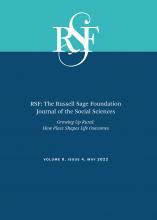Research Article
Open Access
Coming of Age in Appalachia, Emerging or Expedited Adulthood?
Emily E. N. Miller, Kathryn Edin
RSF: The Russell Sage Foundation Journal of the Social Sciences May 2022, 8 (4) 50-67; DOI: https://doi.org/10.7758/RSF.2022.8.4.02
Emily E. N. Miller
aGraduate student of population studies and social policy at Princeton University, United States
Kathryn Edin
bWilliam Church Osborn Professor of Sociology and Public and International Affairs at Princeton University, United States

REFERENCES
- ↵
- American Communities Project
- ↵
- Arnett, Jeffrey Jensen, and
- Jennifer Lynn Tanner
- ↵
- Bernsen, Nicole R.,
- Mindy S. Crandall,
- Jessica E. Leahy, and
- Catharine Biddle
- ↵
- Booth, Alan,
- Susan L. Brown,
- Nancy S. Landale,
- Wendy D. Manning, and
- Susan M. McHale
- ↵
- Brant, Kristina
- ↵
- Burton, Linda M.,
- Daniel T. Lichter,
- Regina S. Baker, and
- John M. Eason
- ↵
- Byun, Soo-yong,
- Judith L. Meece,
- Matthew J. Irvin, and
- Bryan C. Hutchins
- ↵
- Carr, Patrick J., and
- Maria J. Kefalas
- ↵
- Case, Anne, and
- Angus Deaton
- ↵
- Case, Anne, and
- Angus Deaton
- ↵
- ↵
- Copeland, William E.,
- Lauren Gaydosh,
- Sherika N. Hill,
- Jennifer Godwin,
- Kathleen Mullan Harris,
- E. Jane Costello, and
- Lilly Shanahan
- ↵
- Crockett, Lisa J.,
- Michael J. Shanahan, and
- Julia Jackson-Newsom
- ↵
- DeLuca, Stefanie,
- Susan Clampet-Lundquist, and
- Kathryn Edin
- ↵
- Duncan, Cynthia M
- ↵
- Dwyer-Lindgren, Laura,
- Amelia Bertozzi-Villa,
- Rebecca W. Stubbs,
- Chloe Morozoff,
- Shreya Shirude,
- Jürgen Unützer,
- Mohsen Naghavi,
- Ali H. Mokdad, and
- Christopher J. L. Murray
- ↵
- Edin, Kathryn, and
- Maria Kefalas
- ↵
- Edin, Kathryn,
- Timothy Nelson,
- Andrew Cherlin, and
- Robert Francis
- ↵
- Elder, Glen H., Jr.., and
- Rand. D Conger
- ↵
- Ely, Danielle M
- ↵
- Erwin, Paul Campbell
- ↵
- Fergusson, David M.,
- L. John Horwood, and
- Joseph M. Boden
- ↵
- Flippen, Alan
- ↵
- Furstenberg, Frank F.,
- Rubén C. Rumbaut, and
- Richard A. Settersten Jr.
- ↵
- Garrett-Peters, Raymond, and
- Linda M. Burton
- ↵
- Glasmeier, Amy, and
- Priscilla Salant
- ↵
- Hamilton, Brady E
- ↵
- Hansen, Anna C.,
- Robyn Brown,
- Peggy Keller, and
- Nancy Schoenberg
- ↵
- Heflinger, Craig Anne, and
- Brian Christens
- ↵
- Hogan, Dennis P
- ↵
- Johnson, Kenneth M
- ↵
- ↵
- ↵
- Kennedy, Sheela, and
- Steven Ruggles
- ↵
- Kentucky Cabinet for Health and Family Services
- ↵
- Kentucky Cabinet for Health and Family Services
- ↵
- Lewis, Melinda L.,
- Diane L. Scott, and
- Carol Calfee
- ↵
- Manning, Wendy D
- ↵
- Maril, Robert Lee
- ↵
- McLanahan, Sara
- ↵
- McLanahan, Sara, and
- Christine Percheski
- ↵
- Niccolai, Ashely R.,
- Sarah Damaske, and
- Jason Park
- ↵
- Parsons, Ryan
- ↵
- Pickering, Kathleen
- ↵
- Potter, Beth
- ↵
- Rindfuss, Ronald R
- ↵
- Robert Wood Johnson Foundation
- ↵
- Schwarz, Norbert
- ↵
- Settersten, Richard A
- ↵
- Settersten, Richard A.,
- Timothy M. Ottusch, and
- Barbara Schneider
- ↵
- Shanahan, Michael J
- ↵
- Sherman, Jennifer
- ↵
- Sherman, Jennifer, and
- Kai A. Schafft
- ↵
- ↵
- Smith, Sharon G.,
- Jieru Chen,
- Kathleen C. Basile,
- Leah K. Gilbert,
- Melissa T. Merrick,
- Nimesh Patel,
- Margie Walling, and
- Anurag Jain
- ↵
- Social Security Administration
- ↵
- Social Security Administration
- ↵
- ↵
- ↵
- Tieken, Mara Casey
- ↵
- U.S. Census Bureau (Census Bureau)
- ↵
- The Washington Post
- ↵
- Waters, Mary C.,
- Patrick J. Carr,
- Maria J. Kefalas, and
- Jennifer Holdaway
- ↵
- Wuthnow, Robert
In this issue
Coming of Age in Appalachia, Emerging or Expedited Adulthood?
Emily E. N. Miller, Kathryn Edin
RSF: The Russell Sage Foundation Journal of the Social Sciences May 2022, 8 (4) 50-67; DOI: 10.7758/RSF.2022.8.4.02
Jump to section
Related Articles
- No related articles found.
Cited By...
- No citing articles found.





